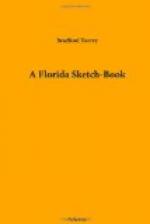I was preparing to surmount the barbed-wire fence again, when the planter returned and halted for another chat. It was evident that he took a genuine and amiable interest in my researches. There were a great many kinds of sparrows in that country, he said, and also of woodpeckers. He knew the ivory-bill, but, like other Tallahasseans, he thought I should have to go into Lafayette County (all Florida people say La_fay_ette) to find it. “That bird calling now is a bee-bird,” he said, referring to a kingbird; “and we have a bird that is called the French mocking-bird; he catches other birds.” The last remark was of interest for its bearing upon a point about which I had felt some curiosity, and, I may say, some skepticism, as I had seen many loggerhead shrikes, but had observed no indication that other birds feared them or held any grudge against them. As he rode off he called my attention to a great blue heron just then flying over the swamp. “They are very shy,” he said. Then, from further away, he shouted once more to ask if I heard the mocking-bird singing yonder, pointing with his whip in the direction of the singer.
For some time longer I hung about the glade, vainly hoping that the grosbeak would again favor my eyes. Then I crossed more planted fields,—climbing more barbed-wire fences, and stopping on the way to enjoy the sweetly quaint music of a little chorus of white-crowned sparrows,—and skirted once more the muddy shore of the cane-swamp, where the yellowlegs and sandpipers were still feeding. That brought me to the road from which I had made my entry to the place some days before; but, being still unable to forego a splendid possibility, I recrossed the plantation, tarried again in the glade, sat again on the wooden fence (if that grosbeak only would show himself!), and thence went on, picking a few heads of handsome buffalo clover, the first I had ever seen, and some sprays of penstemon, till I came again to the six-barred gate and the Quincy road. At that point, as I now remember, the air was full of vultures (carrion crows), a hundred or more, soaring over the fields in some fit of gregariousness. Along the road were white-crowned and white-throated sparrows (it was the 12th of April), orchard orioles, thrashers, summer tanagers, myrtle and paim warblers, cardinal grosbeaks, mocking-birds, kingbirds, logger-heads, yellow—throated vireos, and sundry others, but not the blue grosbeak, which would have been worth them all.
Once back at the hotel, I opened my Coues’s Key to refresh my memory as to the exact appearance of that bird. “Feathers around base of bill black,” said the book. I had not noticed that. But no matter; the bird was a blue grosbeak, for the sufficient reason that it could not be anything else. A black line between the almost black beak and the dark-blue head would be inconspicuous at the best, and quite naturally would escape a glimpse so hasty as mine had been. And yet, while I reasoned




